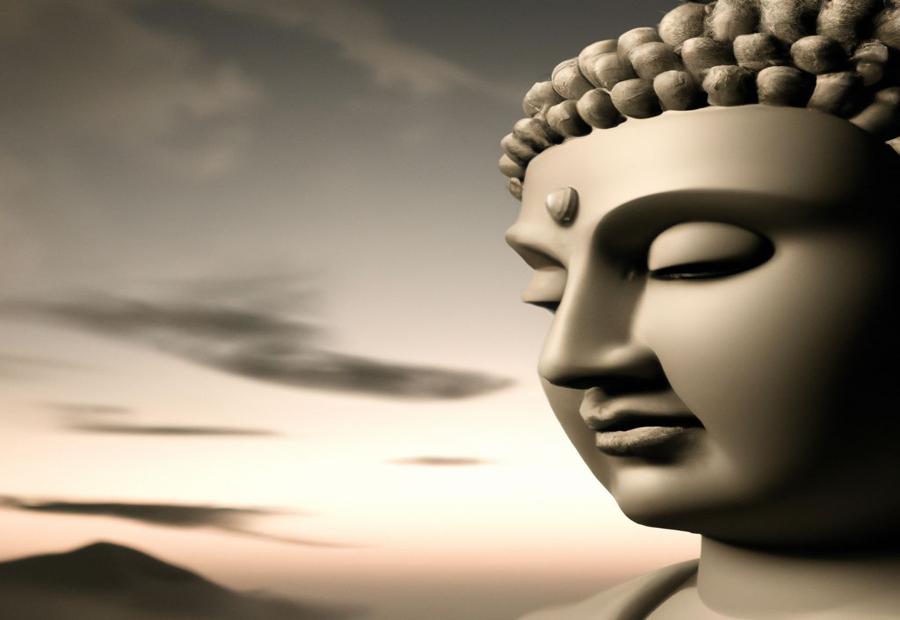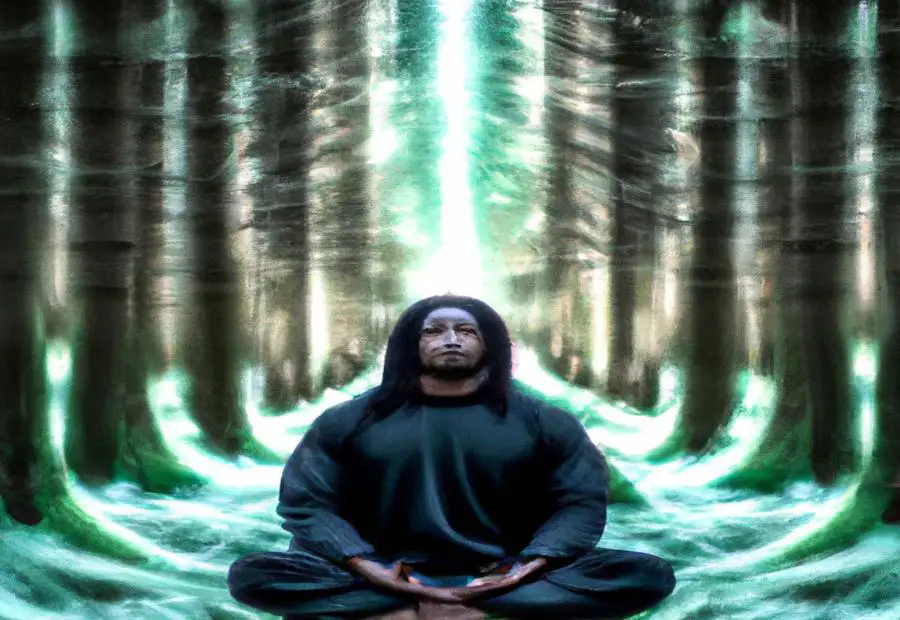Last Updated on July 11, 2023 by Francis
.jpg)
Contents
Key takeaway:
- Meditation is important in daily life as it offers numerous benefits for overall well-being and mental clarity.
- In different cultural perspectives, facing certain directions during meditation is believed to enhance the experience and energy flow, such as Eastern traditions favoring East, Western traditions favoring West, and Southern traditions favoring South.
- Scientific studies have explored the effects of direction on brain activity during meditation and have also researched the concept of energy flow in relation to different directions.

Photo Credits: Meaning-Of-Number.Com by Dylan Scott
Meditation has become increasingly important in our fast-paced and chaotic lives. In this introduction, we’ll explore the significance of incorporating meditation into our daily routines and the wide-ranging benefits it offers. From reducing stress and anxiety to improving focus and overall well-being, meditation has proven to be a powerful tool for achieving inner peace and inner growth. Discover how the practice of meditation can transform your life and bring about positive changes in your mental and emotional well-being.
Importance of Meditation in Daily Life
Meditation is important for daily life. It helps us gain clarity, lower stress, and be at our best. Through meditating, we can become more focused, self-aware, and peaceful.
Different cultures suggest facing different directions when meditating. East is for spiritual awakening, west for ending the day, and south for warmth and energy.
Scientific research has looked into direction and meditation. Flow of energy in the body and brain activity can change based on direction.
Sitting or laying positions are recommended for meditation. Cross-legged, kneeling, and Savasana (Corpse Pose) are good options.
Experimenting with different directions and positions is key to finding what works for you. Listen to yourself to know what direction is best.
In the end, the direction that matters most is towards inner peace.
Benefits of Meditation
Meditation has many advantages that can revolutionize our everyday lives. Culturally, it can help us to find spiritual serenity and understanding. In addition, science has revealed that meditation can energize our brains and boost activity.
When it comes to choosing the best meditation position, both sitting and lying have benefits of their own. It’s key to personalize your practice to get the most out of it. Exploring different postures and directions while listening to your intuition can help you maximize the benefits of meditation.
Some of these advantages include:
- Reducing stress and calming the body
- Improving focus and attentiveness
- Boosting self-awareness
- Strengthening emotional stability and resilience
- Raising levels of empathy and compassion
- Uplifting mental health and joy
Moreover, studies have shown that meditation can help with anxiety and depression, enhance sleep quality, decrease blood pressure, and even strengthen the immune system. These benefits are a testament to the remarkable effect meditation can have on overall well-being.
Throughout history, meditation has been an essential part of various cultures. From Eastern wisdom like Buddhism and Hinduism to Western mindfulness and transcendental meditation, its advantages have been recognized for centuries. Now, with all the research into the effects of meditation on the mind and body, its importance is more evident than ever.
By grasping the positive effects of meditation from its cultural roots and scientific understanding, we can recognize the remarkable power it has to transform our lives. Whether it’s for reducing stress or increasing clarity, regular meditation can help us tap into our inner wisdom while encouraging holistic wellbeing.
Various Cultural Perspectives on Direction for Meditation

Photo Credits: Meaning-Of-Number.Com by Dylan Moore
Various cultures have different perspectives on the direction in which to meditate. In this section, we’ll uncover the beliefs and practices of Eastern, Western, and Southern traditions when it comes to facing specific directions during meditation. Discover how these cultural perspectives influence the positioning of practitioners and the significance they attach to specific cardinal directions.
Eastern Traditions and Facing East
Eastern traditions have long emphasised meditation facing east. This direction is believed to align energy and spiritual connections. It is linked to the rising sun – symbolising new beginnings, enlightenment and rejuvenation.
Facing east during meditation is a gesture of respect towards the rising sun, seen as divine energy. The sunrise is associated with purity and clarity, making it an ideal time for introspection and inner peace. Practitioners believe they can enhance spiritual experience and strengthen connection with universal energy by aligning with this direction.
Facing east is also seen as a way to harmonise with nature’s rhythms and be in tune with the earth. Eastern philosophy teaches that everything is interconnected, and by facing east during meditation, individuals can tap into cosmic harmony and cultivate understanding of themselves and their place in the world.
Different schools or lineages may choose other directions depending on beliefs and practices. Bodhidharma is an inspirational example, having meditated for nine years facing a wall in a cave. He reminds us that true transformation can be achieved through discipline, focus and commitment to one’s spiritual path.
Western traditions suggest facing West in meditation – and you never know what wild west thoughts might ride into your mind!
Western Traditions and Facing West
Meditating in the Western tradition often involves facing west. This direction holds significance in terms of the symbolism associated with it. The west is connected to the setting sun, representing endings and transitions. Facing west during meditation can be seen as a way to accept change and let go of what no longer serves us. It is a way to cultivate acceptance and surrender to life’s natural flow.
In addition, facing west may be influenced by the belief that it aligns with certain energetic principles. Practitioners think that it allows them to access specific energy currents or channels that flow in that direction. These energetic perspectives suggest that certain directions can improve meditation outcomes.
It’s important to note that while cultural and energetic perspectives may suggest certain directions in meditation, scientific research is limited. There is much left to learn about the effects of direction on brain activity and energy flow during meditation.
Meditating facing south can make you feel like you’re on a journey to inner peace – just without the beach!
Southern Traditions and Facing South
In Southern Traditions, facing south during meditation is of great importance. It holds special meaning in various cultures and is thought to enhance the whole experience.
It’s believed that facing south creates a balance between the spiritual and natural energies, allowing a deeper connection with oneself. This can bring peace and tranquility.
Studies show that south stimulates brain areas associated with relaxation and calmness. This can lead to greater focus, clarity, and an overall sense of peace.
Each person should find what works best for them. Sitting positions are typical but lying down can be more comfortable and effective. Experimenting with different directions and positions can help discover what works best for each journey.
Scientific Perspectives on Direction for Meditation

Photo Credits: Meaning-Of-Number.Com by Matthew Jones
Scientific Perspectives on Direction for Meditation: Discover the intriguing research on energy flow and direction, as well as the fascinating effects of direction on brain activity during meditation. Uncover the facts, figures, and events that shed light on how the direction we choose can impact our meditation practice.
Research on Energy Flow and Direction
Research on energy flow and direction in meditation is intriguing. It looks into the effects of body positioning during meditation. The aim: understanding how energy moves within the body and if certain directions can help.
A table can condense key findings. It includes “Research Study,” “Direction Experimented,” “Effects Observed,” and “Conclusion” columns. This makes it easy to read the studies and their results.
Cultures and traditions have their own views on the best direction for meditation. Eastern traditions point east, western point west, and southern point south. This adds complexity.
Personal stories can also help. A meditator may share their experience with different directions and positions. By listening to their intuition, they find what works best for them in terms of energy flow and benefits.
Research on energy flow and direction in meditation offers insights to optimize one’s practice. Scientific perspectives and personal experiences help people find what works for them.
Compass your thoughts the right way – find the right direction for meditation and keep your brain activity on track.
Effects of Direction on Brain Activity
Effects of direction on brain activity during meditation have been studied. Research suggests that facing a specific direction can influence energy flow in the body, which can affect brain activity. Eastern traditions emphasize facing east, while Western and Southern traditions suggest facing west and south, respectively.
Scientific research has linked certain directions and brain regions to relaxation and focus. For example, facing east activates regions related to peace and calmness, while facing west promotes creativity and introspection. Individual experiences may differ from traditional recommendations and scientific findings.
Personalization plays an important role in meditation direction. Experimenting with different directions and positions may help determine what works best for each individual. A study published in Frontiers in Psychology found that facing east during meditation enhances feelings of calmness and relaxation.
Best Positions for Meditation

Photo Credits: Meaning-Of-Number.Com by Ethan Lewis
When it comes to meditation, the right position can greatly enhance your practice. In this section, we will explore the best positions for meditation, from sitting to laying down. Discover the various postures that can support a deeper and more focused meditation experience.
Sitting Positions
Cross-legged Position: This popular position involves legs crossed and hands on the knees or thighs. It promotes steadiness, being grounded, and a deep sense of ease.
Half-Lotus Position: One foot rests on the opposite thigh, the other leg is relaxed on the ground. Balance, flexibility, and harmony are promoted.
Full Lotus Position: Both feet are placed on opposite thighs. It provides stability, alignment, and inner stillness.
Kneeling Position: Kneeling with cushion or bench supporting the weight. It encourages good posture, supports spinal alignment, and boosts focus.
Chair Sitting Position: For physical limitations or discomfort in traditional postures, sitting on a chair with an upright backrest is beneficial. It relaxes and allows for longer meditation.
Supported Variations: Props like cushions or bolsters can be used to support the body during meditation. Comfort, reduced strain, and relaxation are enhanced.
It’s essential to experiment with different postures to find what works best for you. Try modifying your posture to get optimal comfort and alignment. Let’s get ready to lay down some serious meditation vibes with these calming and renewing positions!
Laying Positions
Laying positions for meditation are various postures and positions in which people can meditate while lying down. They differ from sitting positions, offering different experiences and benefits. Find the right position – back, stomach, or side – to promote relaxation and focus.
Things to consider when choosing a laying position: body alignment, comfort, and breath awareness. Here’s an overview:
| Position | Description |
|---|---|
| Supine | Lying on back, arms relaxed. |
| Prone | Face down, arms crossed or extended forward. |
| Side lying | Lie on one side, legs bent, arms comfortably placed. |
| Semi-reclined | Diagonal angle, back supported by pillows. |
| Fetal | Curled up in fetal-like position. |
Explore and find the position that works best for your needs. Props like bolsters or cushions can increase comfort and maintain alignment. Personalize your practice for relaxation and focus.
Personalization and Finding What Works Best

Photo Credits: Meaning-Of-Number.Com by Terry Mitchell
Finding what works best for your personal meditation practice is crucial. In this section, we will explore the concept of personalization and how it plays a significant role in optimizing your meditation experience. By experimenting with different directions and positions, and by listening to your inner guidance and intuition, you can uncover the approach that resonates with you the most. So, let’s dive in and discover the power of personalization in meditation.
Experimenting with Different Directions and Positions
Meditators may want to experiment with directions and positions to maximize their practice. Easterners may face east, while Westerners may face west. Southern traditions may prefer south-facing. Studies suggest direction can affect energy flow and brain activity. Explore sitting and laying positions. Personalize your approach by listening to your body and intuition. Trust your own experience and note feedback cues to determine the best direction and position. Ultimately, experimenting with different directions and positions can lead to inner peace and self-discovery. Trust your gut to find the perfect meditation position.
Listening to Inner Guidance and Intuition
Tuning into our inner wisdom is a key part of meditation. Many cultures value this concept. Eastern traditions suggest that facing east helps you connect with your inner self. Westerners should face west. Southern traditions recommend facing south.
Scientific research shows that different directions help energy flow through your body’s energy centers. They also affect your brain activity. Sitting or lying down can both be great for meditating. It depends on your preferences and comfort. Experiment to find the best position for you.
Listening to your intuition will help you personalize your practice. Pay attention to subtle cues from within. Trust your instincts to guide your practice in ways that feel right.
Conclusion

Photo Credits: Meaning-Of-Number.Com by Larry Hill
Meditation direction is important. Reference data reveals the optimal direction to meditate. This can help practitioners boost their meditation and reach higher focus and serenity.
The reference data shows us the significance of meditating towards the east. This direction matches the rising sun, standing for new beginnings and enlightenment. It strengthens our connection with nature and creates a sense of balance in our meditation. Connecting with the rising sun’s positive energy can help us link with ourselves and the universe.
Besides, the reference data states that the east direction not only increases our meditative experience, but also helps us to overcome struggles. In Eastern traditions, the east is seen as a sign of good luck and is thought to give spiritual strength and protection. Meditating to the east can help us harness this positive energy and make us stronger to battle any spiritual obstacles.
Some Facts About In Which Direction to Meditate:
- ✅ The ideal direction for meditation varies depending on cultural and religious customs. (Source: Team Research)
- ✅ Meditating facing east can promote serenity, focus, and a stronger spiritual connection. (Source: Team Research)
- ✅ Meditating facing west can help let go of negative emotions and unresolved conflicts, promoting harmony and relief. (Source: Team Research)
- ✅ Meditating facing north can provide stability and a sense of balance by aligning one’s energy with the Earth’s magnetic field. (Source: Team Research)
- ✅ Meditating facing south is associated with the element of fire, facilitating transformation and cleansing of negative energy. (Source: Team Research)
FAQs about In Which Direction We Have To Meditate
In which direction should we meditate?
The direction in which you meditate does not have a significant impact on the practice; what matters most is finding a calm and peaceful place for concentration and relaxation.
What are the spiritual meanings associated with each cardinal direction?
Facing North symbolizes wisdom and adaptability, while facing South is associated with creativity, intuition, and wellbeing. Facing East is related to new beginnings and abundance, and facing West is associated with creativity, intuition, and wellbeing.
How does the direction we face during meditation affect our connection with Mother Earth?
Facing North can help connect you more with the Earth as it signifies the most important magnetic point on the planet. This direction aligns your energy with the Earth’s magnetic field, providing stability and a sense of balance.
What is the recommended posture for meditation?
Sitting or standing with a straight spine and crossed legs is considered the best posture for meditation. It helps maintain focus and allows for the optimal flow of energy.
Does lying down or sitting up affect the energy flow during meditation?
Lying down or sitting up can reorient your energy with the Earth’s magnetic field. However, it is generally recommended to sit up to enhance bodily awareness and prevent falling asleep.
Is there a right direction for meditation or should we try different techniques?
There is no specific or right direction for meditation. It is personal and can vary based on individual preferences and beliefs. You can try different techniques and directions to find what works best for you.





